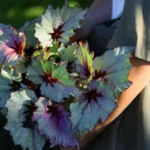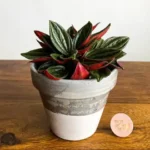Meet the Elegant Calathea Vittata
With its striking foliage and pure decorative charm, Calathea vittata promises to make every indoor plant lover’s heart flutter. A less common—but highly desirable—member of the Marantaceae family, Calathea vittata is adored for its elongated leaves adorned with crisp white stripes that almost look hand-painted. Native to South America, particularly the tropical forests of Brazil, this plant has earned a reputation for being finicky. But with a little patience and the right care, it’s actually a rewarding companion for those drawn to dramatic foliage.
Understanding Calathea Vittata: Appearance and Behavior
The most captivating aspect of Calathea vittata is its foliage. Each leaf is a long, pointed oval in bright green, with symmetrical white or silvery stripes that follow the vein pattern all the way to the edge. Notably, Calatheas are also known as “prayer plants”—a name given due to their nyctinastic movement. This means the leaves move in response to day and night cycles. By nightfall, the leaves slightly fold upwards, resembling praying hands, and they unfurl again with morning light.
Lighting Conditions for Healthy Growth
Getting the light conditions right is crucial to keeping your Calathea vittata happy.
- Bright, Indirect Light: Place your plant near a window with filtered light. East or north-facing windows are ideal. Direct sunlight can scorch the beautiful leaves or fade their vivid patterns.
- Avoid Low Light: While Calathea vittata can tolerate less light than some plants, poor lighting will slow its growth and dull its leaf color. If natural light is limited, consider supplementing with a grow light.
Watering: Keep It Consistent, But Not Soggy
Watering is one of the most delicate aspects of Calathea care. These plants thrive in consistently moist—but not waterlogged—soil.
- Use Distilled or Rainwater: Tap water often contains salts, chlorine, or fluoride, which can damage Calathea leaves over time. Browning tips are often a symptom of poor water quality.
- Check the Top Inch of Soil: Before watering, insert your finger into the top inch of soil. If it feels dry, it’s time to water. Ensure the pot has drainage holes to avoid root rot.
- Humidity Matters: These tropical beauties crave humidity. Aim for at least 50% humidity—ideal levels are closer to 60–70%.
To maintain adequate humidity, try the following:
- Set the pot on a pebble tray filled with water.
- Use a room humidifier, especially during winter.
- Group it with other high-humidity plants like ferns, Fittonia, or Maranta.
Choosing the Right Soil and Pot
Calathea vittata needs a well-draining substrate that still retains some moisture. A good soil mix should be light, airy, and rich in organic matter.
- Recommended Mix: Use a blend of peat moss or coco coir, perlite, and a bit of orchid bark or worm castings.
- Avoid Heavy Soils: Garden soil or potting mixes designed for moisture retention (like those for African violets) can stay too damp and cause root issues.
A pot with drainage holes is essential to allow excess water to escape. Terracotta pots are breathable, but they dry out quicker. Plastic or glazed ceramic pots retain moisture longer but monitor closely for overwatering.
Fertilization and Feeding Schedule
Feeding your Calathea vittata can help maintain its vibrant foliage and support growth. However, overfeeding can damage the roots.
- Frequency: Every 4–6 weeks during the growing season (spring and summer).
- Type: Use a balanced, diluted liquid houseplant fertilizer (e.g., 10-10-10 or 20-20-20 solution at half strength).
- Skip Winter Feeding: In the dormant months of fall and winter, the plant’s growth slows down, and feeding isn’t necessary.
Temperature and Draft Protection
Being a tropical plant, Calathea vittata thrives in stable, warm environments.
- Optimal Temperature Range: 65–80°F (18–27°C).
- Protect from Drafts: Avoid placing your plant near windows, doors, or HVAC vents where sudden temperature changes or dry air can stress the plant.
- Cold Sensitivity: Exposure to temperatures below 60°F can cause leaf damage and even root shock.
Repotting and Pruning Tips
Calathea vittata enjoys a spacious root system but doesn’t require frequent repotting. Expect to repot every 1–2 years.
- When to Repot: If roots are growing out of the drainage holes or the soil dries too quickly, the plant has likely outgrown its pot.
- How to Prune: Trim off any damaged, yellow, or crispy leaves with sterile scissors to redirect the energy toward healthy growth.
Pest and Disease Management
Calathea vittata is relatively pest-resistant but can encounter some issues, especially in dry environments or poor air circulation.
- Spider Mites: The biggest threat—watch for webbing and stippled leaves. Boost humidity and wipe leaves with neem oil solution.
- Fungus Gnats: These may appear in overwatered soil. Let the topsoil dry slightly between waterings and use sticky traps if needed.
- Leaf Spot or Root Rot: Usually caused by excessive moisture. Use well-draining soil and never leave the pot sitting in standing water.
Propagation: Can You Multiply Your Calathea Vittata?
Unlike trailing plants that can be propagated from cuttings, Calathea vittata reproduces best through plant division. This should be done during repotting.
Here’s how:
- Remove the plant gently from its pot and shake off excess soil.
- Locate a natural division—each section should have at least 3–4 leaves and roots.
- Cut or separate the roots using sterile tools, and plant each new division in a fresh pot with similar soil.
- Keep in a warm, humid environment and avoid direct sun until they settle.
Common Issues and How to Troubleshoot
Even experienced plant parents can run into trouble. Here’s how to diagnose and fix common problems:
- Browning Leaf Edges: Often caused by low humidity or fluoridated water. Increase humidity and switch to distilled water.
- Yellowing Leaves: Can indicate overwatering or poor drainage. Let the soil dry out more between waterings.
- Faded Leaf Color: Too much direct sunlight can bleach the vibrant stripes. Move to a location with softer, filtered light.
Conclusion: Calathea Vittata Is Worth the Challenge
Calathea vittata may have a reputation for being high maintenance, but it rewards attentive care with spectacular foliage and fascinating daily movement. Once you get into the rhythm of its needs—consistent watering, high humidity, indirect light, and gentle handling—it becomes a living piece of art on your plant shelf. Perfect for plant parents who enjoy nurturing tropical species and adding a unique flair to their indoor garden, Calathea vittata may just be the centerpiece your collection is waiting for.
References
- Hessayon, D. G. (2013). The House Plant Expert (2nd ed.). Expert Books.
- Iannotti, M. (2021). Organic Gardening for Dummies (3rd ed.). Wiley.
- Wet Tropics Management Authority. (2022). Marantaceae Family – Tropical Plant Characteristics. Retrieved from https://www.wettropics.gov.au








